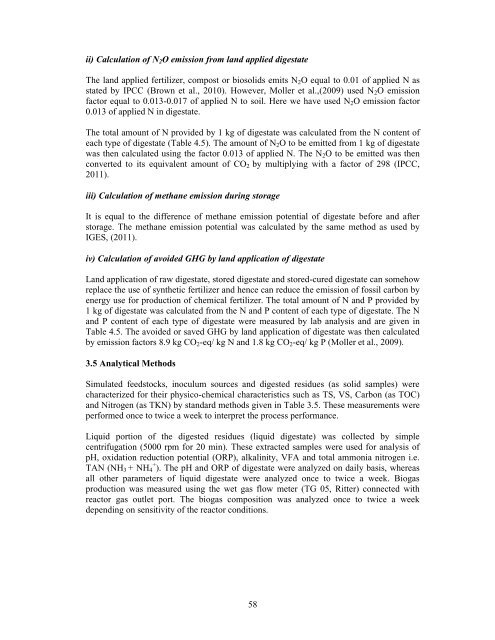dry anaerobic digestion of municipal solid waste and digestate ...
dry anaerobic digestion of municipal solid waste and digestate ...
dry anaerobic digestion of municipal solid waste and digestate ...
Create successful ePaper yourself
Turn your PDF publications into a flip-book with our unique Google optimized e-Paper software.
ii) Calculation <strong>of</strong> N2O emission from l<strong>and</strong> applied <strong>digestate</strong><br />
The l<strong>and</strong> applied fertilizer, compost or bio<strong>solid</strong>s emits N2O equal to 0.01 <strong>of</strong> applied N as<br />
stated by IPCC (Brown et al., 2010). However, Moller et al.,(2009) used N 2O emission<br />
factor equal to 0.013-0.017 <strong>of</strong> applied N to soil. Here we have used N2O emission factor<br />
0.013 <strong>of</strong> applied N in <strong>digestate</strong>.<br />
The total amount <strong>of</strong> N provided by 1 kg <strong>of</strong> <strong>digestate</strong> was calculated from the N content <strong>of</strong><br />
each type <strong>of</strong> <strong>digestate</strong> (Table 4.5). The amount <strong>of</strong> N2O to be emitted from 1 kg <strong>of</strong> <strong>digestate</strong><br />
was then calculated using the factor 0.013 <strong>of</strong> applied N. The N2O to be emitted was then<br />
converted to its equivalent amount <strong>of</strong> CO2 by multiplying with a factor <strong>of</strong> 298 (IPCC,<br />
2011).<br />
iii) Calculation <strong>of</strong> methane emission during storage<br />
It is equal to the difference <strong>of</strong> methane emission potential <strong>of</strong> <strong>digestate</strong> before <strong>and</strong> after<br />
storage. The methane emission potential was calculated by the same method as used by<br />
IGES, (2011).<br />
iv) Calculation <strong>of</strong> avoided GHG by l<strong>and</strong> application <strong>of</strong> <strong>digestate</strong><br />
L<strong>and</strong> application <strong>of</strong> raw <strong>digestate</strong>, stored <strong>digestate</strong> <strong>and</strong> stored-cured <strong>digestate</strong> can somehow<br />
replace the use <strong>of</strong> synthetic fertilizer <strong>and</strong> hence can reduce the emission <strong>of</strong> fossil carbon by<br />
energy use for production <strong>of</strong> chemical fertilizer. The total amount <strong>of</strong> N <strong>and</strong> P provided by<br />
1 kg <strong>of</strong> <strong>digestate</strong> was calculated from the N <strong>and</strong> P content <strong>of</strong> each type <strong>of</strong> <strong>digestate</strong>. The N<br />
<strong>and</strong> P content <strong>of</strong> each type <strong>of</strong> <strong>digestate</strong> were measured by lab analysis <strong>and</strong> are given in<br />
Table 4.5. The avoided or saved GHG by l<strong>and</strong> application <strong>of</strong> <strong>digestate</strong> was then calculated<br />
by emission factors 8.9 kg CO2-eq/ kg N <strong>and</strong> 1.8 kg CO2-eq/ kg P (Moller et al., 2009).<br />
3.5 Analytical Methods<br />
Simulated feedstocks, inoculum sources <strong>and</strong> digested residues (as <strong>solid</strong> samples) were<br />
characterized for their physico-chemical characteristics such as TS, VS, Carbon (as TOC)<br />
<strong>and</strong> Nitrogen (as TKN) by st<strong>and</strong>ard methods given in Table 3.5. These measurements were<br />
performed once to twice a week to interpret the process performance.<br />
Liquid portion <strong>of</strong> the digested residues (liquid <strong>digestate</strong>) was collected by simple<br />
centrifugation (5000 rpm for 20 min). These extracted samples were used for analysis <strong>of</strong><br />
pH, oxidation reduction potential (ORP), alkalinity, VFA <strong>and</strong> total ammonia nitrogen i.e.<br />
TAN (NH3 + NH4 + ). The pH <strong>and</strong> ORP <strong>of</strong> <strong>digestate</strong> were analyzed on daily basis, whereas<br />
all other parameters <strong>of</strong> liquid <strong>digestate</strong> were analyzed once to twice a week. Biogas<br />
production was measured using the wet gas flow meter (TG 05, Ritter) connected with<br />
reactor gas outlet port. The biogas composition was analyzed once to twice a week<br />
depending on sensitivity <strong>of</strong> the reactor conditions.<br />
58

















